Thanks to HV Kumar, I got to know about
Draupadi Kund. He was kind enough to share pictures too. I visited Bhimkutt,
also in Drass, in 2016 but missed the Kund so am extremely grateful to him. In
so many parts of India one hears stories about the Pandavas who visited during
exile, it is quite amazing.
Board Draupadi Kund
Draupadi, daughter of Panchala in
Mahabharata bathed here before the ascending to the heavens in the higher reach
of the Himalayas. Locals believe that drinking the kund water could help a
couple conceive. The temple near the Kund is made in the honour of Draupadi.
The water reflects every hue of the sky
in the summers. And as the season changes so does the colour of the lake. From
blue then green to white in the winters.
Scientists who have explored the lake
believe that the water at the very bottom of the lake does not freeze even on
the coldest day.
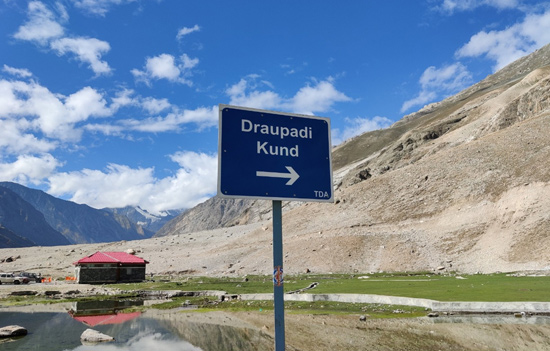
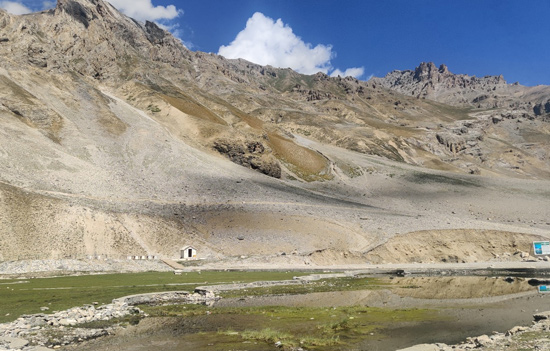 Kund from a distance.
Kund from a distance.
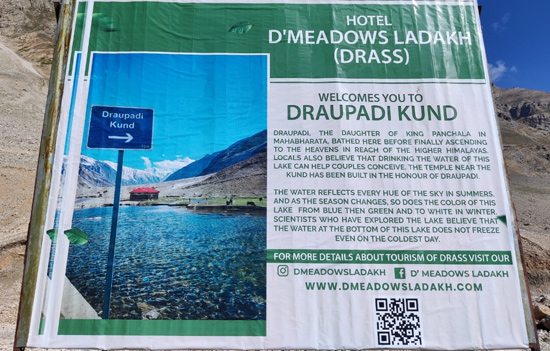
Pictures courtesy HV Kumar who runs a very popular Facebook page on road travel. “There is nobody as expert as HV Kumar (HVK) on knowledge about Indian Highways and Automotive Transport. The magnitude and the detailing of precious and up to date information he has is mind boggling and absolutely unmatched.” To access FB page click HERE
Board Bhimkutt
This stone is associated with the Pandavas i.e. Bhim
during their period of exile. It is situated about 5 kms from Drass town in a
village called Bhimbat.
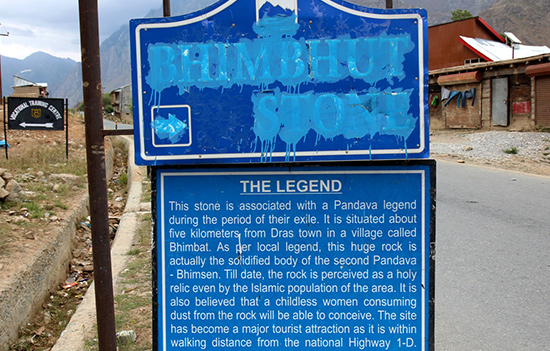
According to local tradition the stone
is the solidified body of Bhimsen. To date the rock is considered as a holy
relic even by the locals of the area. It is believed that a childless woman
consuming dust from the rock shall be able to conceive. It is within walking
distance from National Highway 1-D.
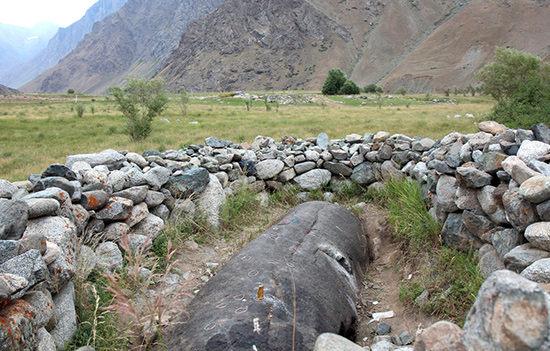
Ayan De & wife Debarati De share experience
on how they reached Bhimkutt.
“On the way from Kargil to Drass on NH1, a
couple of kilometers before the Kargil War Memorial in Drass, lies the village
of Bhimbat. A BRO blue board on the roadside recounts the legend behind the
name. This is about a stone that is associated with the Mahaprasthan or last
journey of the Pandavas as recounted in the Mahabharata. This stone is said to
be the solidified body of the second Pandava Bheemsen who left his mortal abode
at that spot.
Apart from an obscure arrow mark, there
was no indication where exactly the stone lay. This warranted some exploration.
The arrow mark was pointing towards a metalled track that seemed to meander
through a forested land, interspersed with pretty cottages.
Preliminary enquiries with a shopkeeper
revealed that the stone was at about fifteen mins walk from the highway. Not
sure whether the track was wide enough till the end, we decided to park our
vehicle by the highway and started our trek of exploration. There were few
people to ask around, and apart from birdsong, and the occasional sound made by
passing vehicles on the highway, there was hardly any signs of life.
After walking for about half a kilometer, we decided that there was no point walking further. The road seemed to be wide enough to venture further on our Duster and hence we returned to the highway to get our vehicle. Fortunately we met a local family who were driving down at that moment, and we stopped them to ask for directions (more about the family in a later post on Ladakhi hospitality). They asked us to follow their car and soon we were directed to park at a clearing by the hillside. They pointed at a hillock where shepherds were grazing their sheep, and that was where the legendary stone lay, they said. Getting there would mean climbing down one hillock, crossing the valley in between, and climbing up another hillock. In between there were several barbed wire demarcations, that needed to be negotiated. There were neither any pathways built to reach the stone, nor any signposts.
After reaching the hillock, we found
numerous large stones strewn around. That was a natural geological phenomenon
of the place and not anything out of the ordinary. Which was then the proverbial
Bheem Ka Patthar? A shepherd woman afar guessed our confusion. She guided us
towards the direction of the stone, and there it was! This longish stone slab,
enclosed in a stone kraal typical of Ladakh, was different from all other
stones lying around. It was probably a meteorite that became a legend. It is
revered even by the local Muslim women as they believe dust from the stone
helps a childless woman conceive.”
Also see albums
1. Drive
Leh to Kargil
2. Kargil
War Memorial
3. River
Rafting Zanskar
4. Palaces Leh